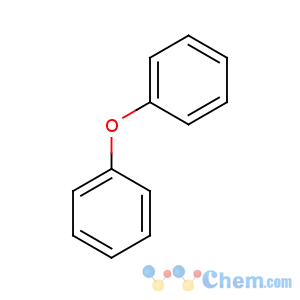Title: Phenyl Ether
CAS Registry Number: 101-84-8
CAS Name: 1,1¢-Oxybisbenzene
Synonyms: diphenyl ether; diphenyl oxide
Molecular Formula: C12H10O
Molecular Weight: 170.21
Percent Composition: C 84.68%, H 5.92%, O 9.40%
Line Formula: C6H5OC6H5
Literature References: Prepd by heating sodium phenolate with chlorobenzene.
Properties: Liquid; characteristic odor. d20 1.075 (liq); mp 28°, and remains liq at lower temp; bp 259°. Flash pt 115°C. Insol in water; sol in alcohol, benzene, ether, glacial acetic acid.
Melting point: mp 28°
Boiling point: bp 259°
Flash point: Flash pt 115°C
Density: d20 1.075 (liq)
CAUTION: Potential symptoms of overexposure to vapor are nausea; irritation of eyes, nose and skin.
See NIOSH Pocket Guide to Chemical Hazards (DHHS/NIOSH 97-140, 1997) p 248.
Use: As heat transfer medium; in perfuming soaps; in organic syntheses.

